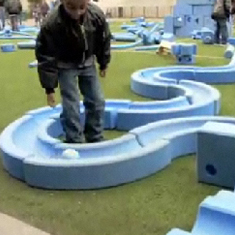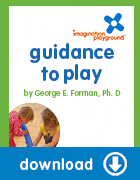Since the parts are moveable, children will naturally create all sorts of boundaries, paths, and obstacle courses.
It is interesting to watch how the children will deliberately make an activity more challenging by expanding the distance between “stepping stones” or raising the bar on a hurdle.

The long curving blocks make interesting paths for a ball. The children can alternate the curves to see how the overall path changes when that rule is applied, or when variations of that rule are applied and result in a closed loop.

With these large blocks children can design challenging structures that allow multiple players to follow the leader.
What It Means
These games create opportunities for the children to negotiate rules among themselves—what constitutes a successful finish or a winning run. Some of the paths will just be paths and the intrigue comes from not knowing in advance exactly where you will end up, like weaving through the empty spaces of an accidental maze.
2-4 Year Olds
Younger children will no doubt want to walk on the block path as do the older children. Try to judge if they have sufficient body awareness to know what they can do. Also, note that they may be just as content remaining in some of the vacant spaces because these spaces are cozy.
4-7 Year Olds
As the children get older the rules become more complicated. They learn the difference between a rule and a strategy. A strategy is something you might do, such as, “start on your right foot,” but sometimes children confuse a strategy with a rule and say, “you have to start on your right foot.” In the same vein, having an objective is not the same as using a rule.
7-10 Year Olds
The older children will probably bring up the issue of different rules for different ability levels, such as, “Let the little guy go around the hard part.” Think about the complexity of the path and how well the children anticipate which way to go. Does it bother them if they come out some place they did not expect? Treat that awareness as a mark of their intelligence.
This material is adapted from the publication “Imagination Playground’s Guidance to Play” by George E. Forman, PhD, Emeritus Professor, University of Massachusetts (Amherst) and President of Videatives, Inc.
Dr. Forman has over 33 years of experience in university teaching, cognitive research, multimedia design and educational consulting in the area of early childhood learning and development.
“Guidance to Play” covers 20 topics that help illustrate the significance in what children are doing as they play as well as concrete actions Play Associates can take to facilitate positive behaviors.



